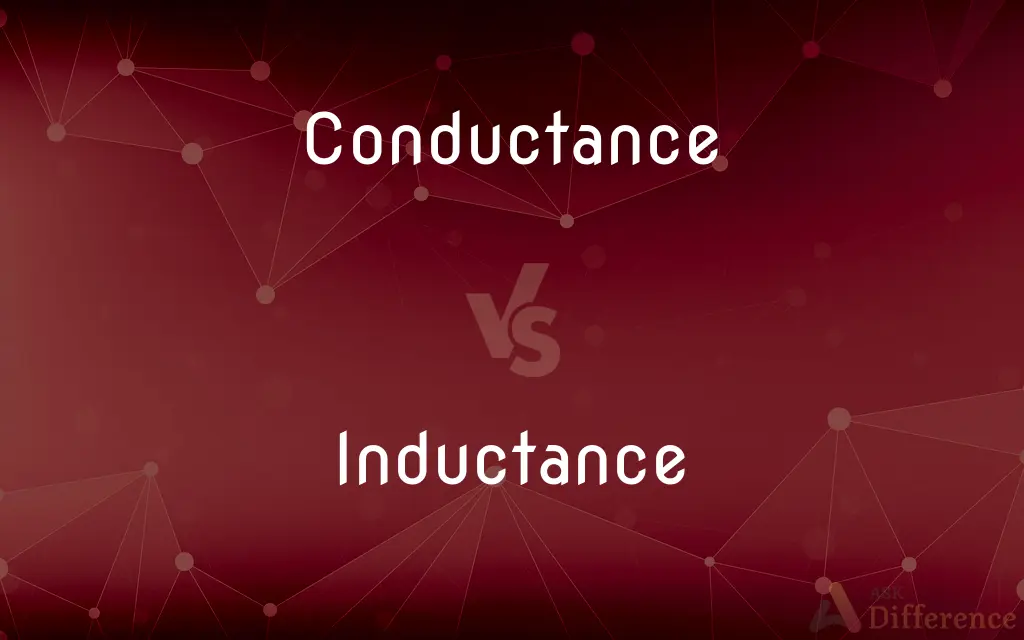Conductance vs. Inductance — What's the Difference?
By Maham Liaqat & Fiza Rafique — Updated on April 26, 2024
Conductance measures the ease with which an electric current flows through a material, quantified in siemens (S), while inductance measures the ability of a conductor to induce voltage when current flowing through it changes, quantified in henries (H).

Difference Between Conductance and Inductance
Table of Contents
ADVERTISEMENT
Key Differences
Conductance is the reciprocal of electrical resistance and describes how well a conductor allows the passage of electric current. It is especially important in discussions about the efficiency of electrical circuits, as higher conductance implies lower resistance and hence easier flow of electricity. In contrast, inductance is a property of electrical conductors that causes them to oppose changes in electric current passing through them. This quality is particularly significant in alternating current (AC) circuits and in the designing of transformers and inductors.
The unit of conductance, the siemens, signifies a component's ability to conduct electric current. Higher conductance means a material or component offers less opposition to current flow. Conversely, the unit of inductance, the henry, represents the extent to which a component such as a coil can store magnetic energy, essentially resisting changes in current that flows through it.
Conductance is primarily influenced by the material’s properties such as its conductivity, dimensions, and temperature. Metals with high conductivity, like copper and silver, typically exhibit high conductance. Meanwhile, inductance depends on factors like the number of turns in the coil, the coil's area, the type of core material, and how the coil is wound. More turns or a ferromagnetic core increases a coil’s inductance.
In practical applications, conductance is crucial for determining how efficiently electrical devices operate, influencing everything from electrical wiring to high-precision resistors. Inductance is key in the function of transformers, motors, and generators, where it is used to convert energy from one form to another efficiently.
While conductance focuses on the ease of current flow within a conductor, inductance involves the interaction between currents and magnetic fields within circuits, emphasizing how current changes influence voltages and vice versa.
ADVERTISEMENT
Comparison Chart
Definition
Ability to conduct electric current, inverse of resistance.
Ability to induce voltage as a result of a change in current flow.
Unit of Measure
Siemens (S)
Henry (H)
Influenced By
Material properties, dimensions, and temperature.
Number of turns, core material, coil geometry.
Importance in
Efficiency of current flow in circuits.
Energy storage and current regulation in AC circuits.
Key Applications
Electrical networks, resistors, semiconductors.
Transformers, motors, inductors, filters.
Compare with Definitions
Conductance
Measured in siemens, indicative of a material’s ability to conduct electricity.
The device was designed with high conductance materials to reduce energy loss.
Inductance
Property of a conductor by which a change in current in the conductor induces a voltage in both the conductor itself and in nearby conductors.
The inductance of the coil in the motor plays a critical role in its operation.
Conductance
Impacted by material, cross-sectional area, and temperature.
As temperature increases, the conductance of semiconductors typically increases.
Inductance
Measured in henries, reflects the efficiency of energy storage in magnetic fields.
The transformer was designed with high inductance to improve energy transfer.
Conductance
The property of allowing the flow of electric current; inversely related to resistance.
The conductance of a silver wire is high due to its low resistivity.
Inductance
Crucial for the operation of AC circuits and electronic components.
Inductors are used to manage power supply in AC circuits.
Conductance
Used to describe components in electrical circuits.
Engineers prefer materials with higher conductance for efficient circuit design.
Inductance
Affects how circuits respond to changes in current.
Inductance is critical in designing circuits that must handle rapidly changing currents.
Conductance
Reflects the ease of electric current passage through a conductor.
Copper exhibits high conductance, making it ideal for electrical wiring.
Inductance
Dependent on factors such as coil turns and core material.
Adding more turns to the coil increases its inductance.
Conductance
Symbol G A measure of a material's ability to conduct electric charge; the reciprocal of the resistance.
Inductance
Inductance is the tendency of an electrical conductor to oppose a change in the electric current flowing through it. The flow of electric current creates a magnetic field around the conductor.
Conductance
Thermal conductance.
Inductance
The property of an electric circuit by which an electromotive force is induced in it as the result of a changing magnetic flux.
Conductance
(physics) A measure of the ability of a body to conduct electricity; the reciprocal of its resistance.
Inductance
A circuit element, typically a conducting coil, in which electromotive force is generated by electromagnetic induction.
Conductance
Conducting power; - the reciprocal of resistance. A suggested unit is the mho, the reciprocal of the ohm.
Conductance is an attribute of any specified conductor, and refers to its shape, length, and other factors. Conductivity is an attribute of any specified material without direct reference to its shape or other factors.
Inductance
(physics) The property of an electric circuit by which a voltage is induced in it by a changing magnetic field.
The power cable itself has enough inductance to disrupt the digital signal of the video output cable, due to poor shielding.
Conductance
A material's capacity to conduct electricity; measured as the reciprocal of electrical resistance
Inductance
The quantity of the resulting electromagnetic flux divided by the current that produces it, measured in henries (SI symbol: H.)
What is the inductance of that power supply's main inductor?
Inductance
Capacity for induction; the coefficient of self-induction.
Inductance
(physics) a property of an electric circuit by which an electromotive force is induced in it by a variation of current
Inductance
An electrical device that introduces inductance into a circuit
Common Curiosities
Why is inductance important in transformers?
Inductance in transformers allows for the efficient transfer of energy between circuits through magnetic flux, without direct electrical connection, making it essential for voltage conversion.
What unit is inductance measured in?
Inductance is measured in henries (H).
How does temperature affect conductance?
Temperature can significantly affect conductance; for most metals, conductance decreases with an increase in temperature due to increased atomic vibrations, which impede the flow of electrons.
Can conductance be negative?
Conductance cannot be negative; it is a measure of a material's ability to conduct electricity and is always a positive value.
What does conductance measure in an electrical circuit?
Conductance measures the ease with which an electric current can flow through a conductor.
What are practical applications of inductance in everyday electronics?
Inductance is used in everyday electronics in filters, sensors, and inductors to regulate voltage, filter noise, and stabilize circuits against changes in current.
How do inductors use inductance to store energy?
Inductors use inductance to store energy in the form of a magnetic field when current flows through them. This stored energy is released back into the circuit when needed, such as in power supply smoothing or in filter circuits.
What are examples of materials with high conductance?
Silver, copper, and gold are examples of materials with high conductance, often used in electrical and electronic applications due to their excellent ability to conduct electricity.
What happens to inductance when the frequency of the current changes?
Inductance itself does not change with frequency, but its effect on the circuit, such as the impedance, increases with frequency. Higher frequencies lead to higher inductive reactance, which opposes the flow of alternating current.
Is there a way to increase the conductance of a material?
Increasing the cross-sectional area of a material, using materials with higher conductivity, or decreasing the length can increase the conductance.
How does the core material affect the inductance of a coil?
The core material affects the inductance of a coil by enhancing the magnetic field created by the coil. Ferromagnetic materials like iron increase the inductance substantially compared to air or non-magnetic materials.
What role does conductance play in electronic devices?
Conductance is crucial in determining how much current can flow through components of electronic devices, affecting their overall efficiency and power consumption.
How do you measure conductance?
Conductance is typically measured by determining the current flow through a material when a known voltage is applied, using the formula G = I/V, where G is conductance, I is current, and V is voltage.
Does inductance have an effect on direct current (DC)?
Inductance has minimal effect on steady direct current (DC) as it primarily opposes changes in current. However, at the moment of switching DC on or off, inductance can cause spikes in voltage.
Share Your Discovery

Previous Comparison
Nonarbitrary vs. Arbitrary
Next Comparison
Progress vs. ProceedAuthor Spotlight
Written by
Maham LiaqatCo-written by
Fiza RafiqueFiza Rafique is a skilled content writer at AskDifference.com, where she meticulously refines and enhances written pieces. Drawing from her vast editorial expertise, Fiza ensures clarity, accuracy, and precision in every article. Passionate about language, she continually seeks to elevate the quality of content for readers worldwide.
















































